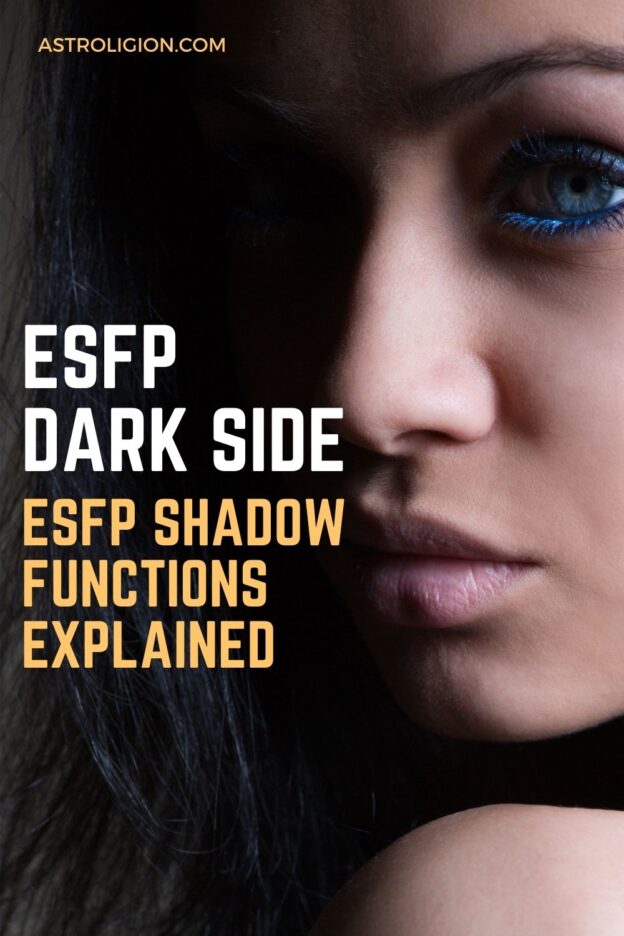Each of the 16 Myers Briggs personality types represent a package of cognitive functions that together form a portrait of a conscious ego identity. The functions that constitute our MBTI type encapsulate the conscious preferences and perspectives that help explain and inform our behavior and tendencies. There is also an unconscious side of our personality that is repressed. This theoretical side of ourselves is known as the shadow and encompasses the things we reject and disassociate from our ego identity.
Carl Jung originally conceptualized the shadow as a feature of the inferior function. He believed the inferior function was the gateway to the shadow. Jungian analyst John Beebe, later described the shadow in terms of cognitive function archetypes. By inverting the attitude (the introverted or extraverted preference) of each cognitive function of a particular type, you get the shadow version of that type. For the ESFP, their shadow would therefore be the ISFJ. The shadow type represents perspectives that are ego-dystonic which is to say, they clash with or obstruct the ego identity.
The important thing to understand is that the shadow is a part of us and can manifest as negative projections we unduly impose on others. Being aware of the shadow can help us manage disruptive and destructive parts of our psyche that we may not even realize are happening. Here now is a look at the ESFP shadow functions and how they manifest in their personality.
ESFP 5th Function: Si Opposing
The ESFPs 1st shadow function is Si Opposing. The opposing function emerges in response to the dominant function being obstructed or opposed. Extraverted Sensing is the ESFPs dominant preference. This means they approach life with an openness to new and stimulating experiences. Se is all about living in the moment and engaging with their environment. Introverted Sensing on the other hand is focused on experience stored in memory. It relies heavily on past precedent and favors things of historical and traditional significance. Si prefers that which is familiar and routine over the risky and unpredictable.
When the ESFP’s dominant Se perspective feels obstructed or opposed by Si-related perspectives, ESFPs may become oppositional. Their preference for freedom to improvise and operate on instinct can feel encumbered and heavily restricted by an Si emphasis on rote memorization and adherence to procedure. They may become frustrated and impatient when they feel such rules and step-by-step procedures are slowing them down or holding them back in some way. ESFP’s shadow Si is used to defend and justify their dominant Se perspective while projecting an antagonistic Si persona onto the person obstructing them. They may argue against them for being “old fashioned”, “boring” or “narrow-minded”. Additionally, they may bring up things about the past that undermine the other person and support ESFP’s Se viewpoint about the present.
ESFP 6th Function: Fe Critical Parent
ESFP’s 2nd shadow function and 6th function overall, is Fe Critical Parent. The critical parent function represents how we sometimes defend the authority of our auxiliary function also referred as the “good parent”. The auxiliary function supports and affirms the dominant function and for extraverted types like ESFP, it describes the nature of their introverted side. ESFP’s auxiliary introverted feeling signifies their humane and personal sense of values. ESFPs use their introverted feeling to nurture and mentor both themselves and others. They have a sense of idealism and self belief that has the power to encourage and inspire.
Fe critical parent on the other hand, describes the way in which ESFP may tear down or demoralize others when they feel cranky or disgruntled. Typically in response to having the authority of their Fi personal values being undermined or taken for granted by what they perceive as standardized group values that don’t represent them as an individual. Under such conditions, ESFPs may use their shadow Fe to assert their moral authority upon others. They may also chastise others for disrupting social harmony while ironically disrupting it themselves. Fe critical parent manifests as a bit of defensive moral grandstanding and shaming others when they feel guilty about disobeying group standards and values.
ESFP 7th Function: Ti Trickster
ESFP’s 3rd shadow function and 7th function overall is Introverted Thinking. This is the shadow side of their tertiary Extraverted Thinking. The tertiary function is described as a “relief role” and backup to the auxiliary function with which it works in tandem. The tertiary function also describes alternative ways in which we like to be creative and have fun. Thus, when they have time for it, ESFPs derive some fun and ego gratification from organizing their environment and doing technical planning. As with other types, ESFPs may sometimes overestimate or “inflate” the strength of their tertiary Te function as being equal to the dominant or auxiliary Te function of other types.
Ti Trickster is a response to feeling “double-bound” and threatened by another person’s Ti logic. When another person finds flaws or pokes holes in the way ESFP organizes or structures things, it can arouse ESFP’s shadow Ti. ESFPs may feel confused or emotionally wounded when someone essentially points out the stupidity of how or why they organized things the way they did. ESFPs will therefore attempt to use individual reference to invalidate the other person’s logic and turn the tables on them. ESFPs may use specious logic just to trap and make the other person appear stupid.
ESFP 8th Function: Ne Demon
Finally, we have ESFP’s 4th shadow function, Ne Demon. The Demon function is the most suppressed area of consciousness. It is referred to as an “internal saboteur” and manifests as an exaltation of one’s own integrity via the cognitive function that inhabits it. In the case of the ESFP, creativity and openness to new ideas becomes a narcissistic basis for their own ego worth. At the same time, they impute evil intent behind others’ words and deeds. In response to feeling befuddled by other’s abstract observations and conceptualizations, it is suspected that the other person is deliberately taking advantage of this. ESFPs may then overread between the lines, so to speak, and attribute negative intent where none was intended.
ESFP posts:
- ESFP Explained: What it Means to be the ESFP Personality Type.
- ESFP Weaknesses; 7 Struggles of Being ESFP
- 35 signs you are an ESFP Personality
- 12 Shades of ESFP: MBTI & the Zodiac
related posts:
Want to know your astrology placements? You can generate your astrology chart here with our free birth chart generator tool.
- ISFJ Shadow: The Dark Side of ISFJ
- ESTP Shadow: The Dark Side of ESTP
- ENFJ Shadow: The Dark Side of ENFJ
- ENFP Shadow: The Dark Side of ENFP
- INTJ Shadow: The Dark Side of INTJ
- ISFP Shadow: The Dark Side of ISFP
- ISTP Shadow: The ISTP Dark Side
- INFP Shadow: The Dark Side of INFP
- ENTP Shadow: The Dark Side of ENTP
- INTP Shadow
- ENTJ Shadow: The Dark Side of ENTJ
- ISFJ Shadow: The Dark Side of ISFJ
- The Dark Side of the INFJ Personality
- The Shadow Ego of Each Myers Briggs Type
- The 8 Cognitive Functions Explained - May 17, 2025
- American Presidents Ranked By Zodiac Sign - January 20, 2025
- ESTP and ESFP in love: 6 Dynamics of Their Relationship - September 4, 2024






Carl Jung’s Definition About Shadow Work is Just Amazing.